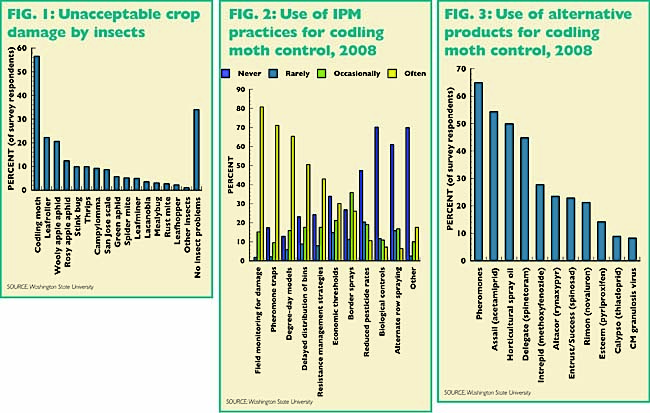Washington apple growers are adopting new pest management strategies and technologies including safer chemistries, in accordance with the U.S. Environmental Protection Agency phaseout of azinphos-methyl (AZM-Guthion) in tree fruits. Because the new chemistries require more precise timing and better spray coverage, use of predictive models and improved application delivery systems are more important than ever before.
The Pest Management Transition Project was funded by the Washington State legislature and a Washington State Department of Agriculture specialty crop grant to help Washington apple growers overcome barriers to adoption of new pest control technologies through a comprehensive program of education, training, and assessment. The PMTP’s mission is to facilitate tree fruit productivity alongside improved environmental and worker health. As part of these efforts, the PMTP has surveyed tree fruit industry stakeholders to understand barriers to adoption and how best to deliver successful IPM programs within the industry.
Grower survey
A survey conducted in the winter of 2009 asked apple growers about their pesticide use and perspectives relative to the 2008 growing season. The survey was designed to assess knowledge of the Guthion phaseout and IPM alternatives, and industry approaches to the challenge of changing pest control practices.
The survey was sent to 1,458 growers, a 50% sample of the industry. Eighty-six percent were orchard owners, and 13% were hired orchard managers. In aggregate, respondents managed close to 78,000 acres of apples, just under half of the bearing apple acreage in the state. The average orchard size was 193 apple acres, about 11% of which were managed organically or in transition to organic and 29% managed conventionally but without use of organophosphate insecticides.
Pests of concern
Fifty-seven percent of respondents identified codling moth as the number-one pest causing unacceptable crop damage in orchards. Nearly 75% felt that if no controls were applied for a year, they would experience more than 10% crop loss. More than 20% of respondents reported leafroller and woolly apple aphid as causing unacceptable crop damage, while 34% reported no insect problems in their apple orchards (Figure 1).
Pest management practices
Eighty percent of orchard owners and managers used Guthion as part of their codling moth control program in 2008, and 70% of those used two to three applications. Sixty-five percent were in the process of reducing Guthion use. Fifty percent reported a reduction in organophosphate use from 2006 to 2008, while 40% reported no change in use.
Growers also used a variety of alternative techniques for managing codling moth in 2008. Sixty-five percent of growers used pheromone mating disruption. Eighty-two percent used pheromone traps to monitor for pests. The biggest barriers to monitoring were lack of time, high cost, and lack of trained staff. Other IPM tactics used included degree-day models, delayed distribution of bins, and resistance management strategies (Figure 2). In 2008, the most commonly used alternative sprays for codling moth were Assail (acetamiprid), horticultural spray oil, and Delegate (spinetoram) (Figure 3).
While growers continued to use organophosphate insecticides, they also expressed confidence in their use of alternatives, especially pheromone mating disruption, Assail, and Delegate. The greatest barriers to using alternatives were cost (68%), effectiveness (53%), secondary pest problems (42%), concerns about residues on exports (30%), and confusion over timing (27%). Fifteen percent of respondents said they did not face barriers.
Information sources
While a majority of orchard owners and managers agreed that codling moth control costs and production risks would be higher after the Guthion phaseout, over 65% agreed that WSU research has developed good information on alternatives to Guthion. Only 8% of respondents anticipated having difficulties in training workers to use alternatives to Guthion. However, only one-third of respondents felt that the Guthion phaseout would protect worker health and the environment.
Survey respondents identified agricultural chemical distributor field representatives, the WSU Crop Protection Guide, insecticide label information, and conferences, workshops, or seminars as their most important sources of information about apple pest management. Thirty-seven percent reported using the WSU Decision Aid System, 53% knew about the PMTP, and 18% had participated in a PMTP Implementation Unit. Sixty-two percent indicated they would be interested in more training on the use of Guthion alternatives.
Following up
The PMTP hopes to follow-up on these initial assessments with a second grower survey for the 2010 season. Combined with consultant survey data from 2007 and 2009, this information will allow for analyses of IPM adoption over time. It will also provide insight on how to guide future PMTP meetings and outreach efforts to facilitate and support the use of IPM throughout the tree fruit industry.
Apple growers, managers, and consultants who are interested in adopting organophosphate alternatives or participating in a PMTP Implementation Unit should call the WSU Tree Fruit Research and Extension Center at 509 663-8181, ext. 257 or 260, or visit the PMTP Web site for more information (http://pmtp.wsu.edu). The Web link entitled “How to Get Involved” allows Web users to sign up for an Implementation Unit or receive newsletters and updates. For further details on the results of this survey, visit http://pmtp.wsu.edu/impacts.html.


Leave A Comment